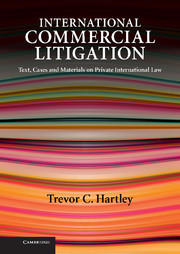Book contents
- Frontmatter
- Contents
- Table of panels
- List of figures
- Preface
- Acknowledgments
- Terminology
- Table of Latin phrases
- List of abbreviations
- Table of cases
- Table of cases (European Court of Justice, numerical order)
- Table of legislative instruments
- PART I STARTING OFF
- PART II JURISDICTION
- PART III FOREIGN JUDGMENTS
- PART IV PROCEDURE
- PART V CHOICE OF LAW
- 22 Introduction to choice of law
- 23 Torts
- 24 Contracts: the principle of party autonomy
- 25 Contracts: legal policy and choice of law
- 26 Contracts: regulating business, protecting employees and helping consumers
- 27 Foreign currency
- 28 Property: tangible movables
- 29 Contractual rights and property interests – I
- 30 Contractual rights and property interests – II
- 31 Contractual rights and property interests – III
- PART VI EXTRATERRITORIALITY
- Bibliography
- Index
30 - Contractual rights and property interests – II
from PART V - CHOICE OF LAW
- Frontmatter
- Contents
- Table of panels
- List of figures
- Preface
- Acknowledgments
- Terminology
- Table of Latin phrases
- List of abbreviations
- Table of cases
- Table of cases (European Court of Justice, numerical order)
- Table of legislative instruments
- PART I STARTING OFF
- PART II JURISDICTION
- PART III FOREIGN JUDGMENTS
- PART IV PROCEDURE
- PART V CHOICE OF LAW
- 22 Introduction to choice of law
- 23 Torts
- 24 Contracts: the principle of party autonomy
- 25 Contracts: legal policy and choice of law
- 26 Contracts: regulating business, protecting employees and helping consumers
- 27 Foreign currency
- 28 Property: tangible movables
- 29 Contractual rights and property interests – I
- 30 Contractual rights and property interests – II
- 31 Contractual rights and property interests – III
- PART VI EXTRATERRITORIALITY
- Bibliography
- Index
Summary
In the previous chapter, we considered various kinds of contractual debts. In this chapter, we take the matter further by considering more complicated questions – shares in a company, and the procedure for debt enforcement now known as a third-party debt order.
Shares
Under English law, the rights of a shareholder against the company are regarded as being based on contract. This is not, however, the position in many other legal systems. If a shareholder deals with his shares – whether by transferring them outright or by pledging them as security for a debt – his rights against the other party under the contract of sale or pledge are governed by the law applicable to that contract. However, as soon as other parties enter the picture, the lex situs becomes important. Deciding what the situs of a share is can give rise to problems.
The common law
We first consider the position under the common law; then we will see whether the Rome I Regulation affects the matter.
Canada
Braun v. Custodian
Exchequer Court of Canada
[1944] 3 DLR 412; affirmed [1944] SCR 339; [1944] 4 DLR 209 (Supreme Court of Canada)
Background
In 1919, Braun, a naturalized US citizen, went to Germany and bought shares in the Canadian Pacific Railway Company, a company incorporated in Canada by a special Act of the Canadian Parliament. The previous owners of the shares were German nationals.
- Type
- Chapter
- Information
- International Commercial LitigationText, Cases and Materials on Private International Law, pp. 756 - 776Publisher: Cambridge University PressPrint publication year: 2009



